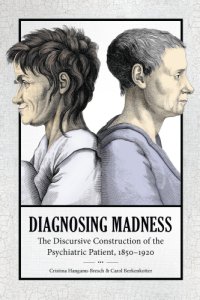"Diagnosing Madness is a study of the linguistic negotiations at the heart of mental illness identification and patient diagnosis. Through an examination of individual psychiatric case records from the late nineteenth and early twentieth centuries, Cristina Hanganu-Bresch and Carol Berkenkotter show how the work of psychiatry was navigated by patients, families, doctors, the general public, and the legal system. The
results of examining those involved and their interactions show that the psychiatrist's task became one of constant persuasion, producing arguments surrounding diagnosis and asylum confinement that attempted to reconcile shifting definitions of disease and to respond to sociocultural pressures. By studying patient cases, the emerging literature of confinement, and patient accounts viewed alongside institutional records, the authors trace the evolving rhetoric of psychiatric disease, its impact on the treatment of patients, its implications for our contemporary understanding of mental illness, and the identity of the psychiatric patient. Diagnosing Madness helps elucidate the larger rhetorical forces that contributed to the eventual decline of the asylum and highlights the struggle for the professionalization of psychiatry."--."This book is the result of years of research spent in archives and libraries on two continents in an attempt to decipher the textual footprints of asylum patients. Some of the results of this research have already been published in Carol Berkenkotter's book Patient Tales: Case Histories and the Uses of Narrative in Psychiatry, as well as in various journals. Here, we focus on tracing not just the patients' medical histories but also their life stories before they became patients and after they were discharged. We find that the diagnosis event is the watershed moment in their lives, and so we are looking for the textual--and textural--makeup of this decision. This was our own version of "starring the text," in the words of Alan Gross, of placing rhetorical analysis of the written word at the center of the web of cultural practices that made asylums possible in the nineteenth century; thus, we observe firsthand the psychiatric argumentation practices that led to diagnosis and the patients' efforts to counter those arguments. For a while we inhabited a world of fading calligraphy inscribed in esoterically paginated dusty tomes, amalgamated genres that also hosted occasional patient letters and artifacts (drawings, paintings, diagrams, objets d'art sometimes engraved in what appeared to be the patient's own blood). Whenever possible, case notes, certificates, and private correspondence were copied, transcribed, and analyzed (in some instance coded); and while we used various analytical frameworks, for the most part we let the texts guide us to what we hoped to be intelligible, plausible approximations of the embodied experience of mental illness for those who found themselves in an asylum"--.
Read more... 